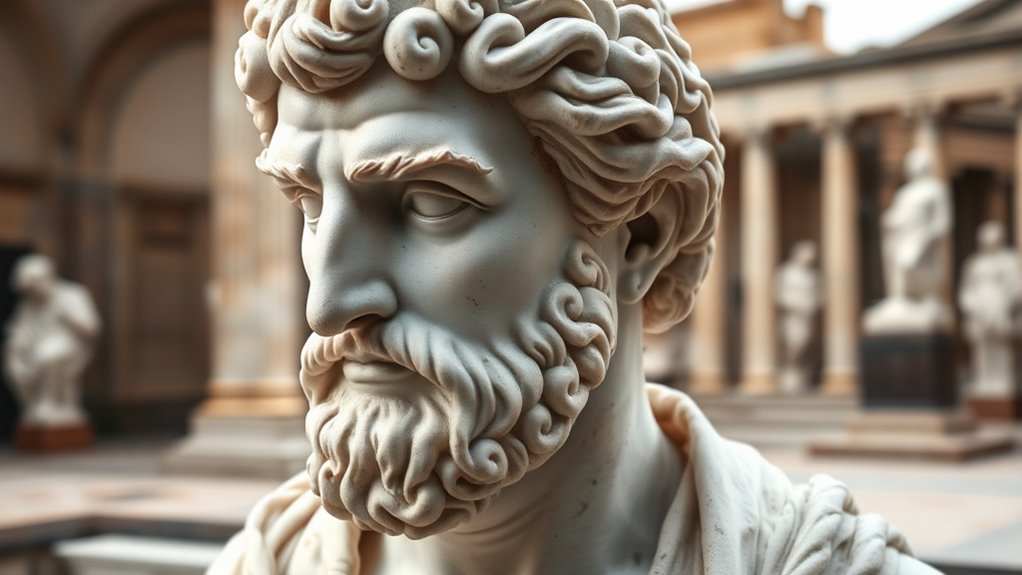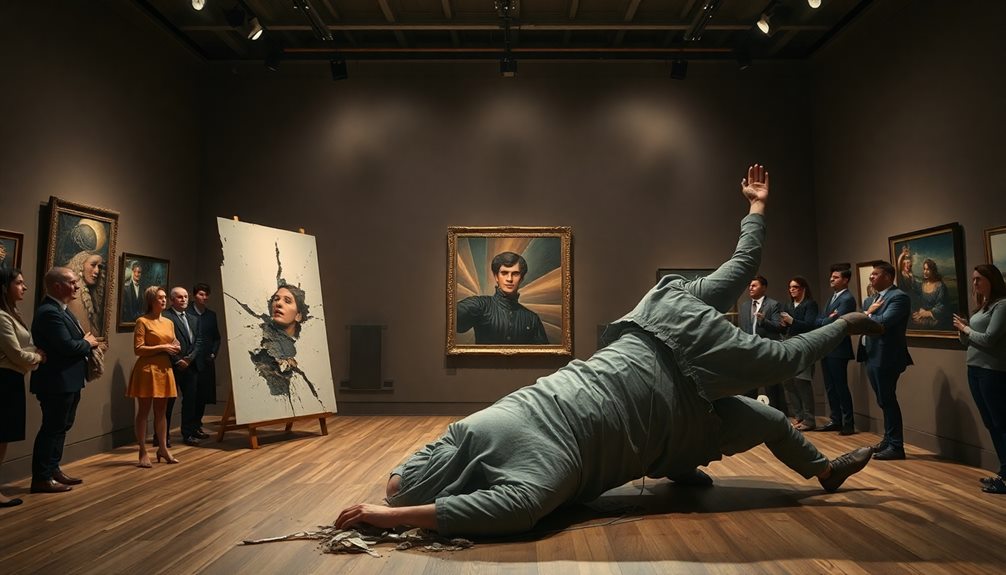Classical masterpieces from ancient Greece and Rome showcase extraordinary marble sculptures that capture human realism, mythological stories, and artistic mastery. You’ll see detailed figures of gods, heroes, and legendary creatures in perfect proportions and graceful poses. These artworks reflect cultural values and religious beliefs, emphasizing emotion, movement, and storytelling. If you want to explore how these timeless sculptures influenced Western art and inspire awe today, keep going to discover their enduring significance.
Key Takeaways
- Greek and Roman marble sculptures masterfully depict mythological gods, heroes, and legendary creatures with realism and idealized beauty.
- Techniques like naturalism, detailed anatomy, and harmonious proportions define their stylistic achievements.
- Iconic works such as Athena Parthenos exemplify mythological themes central to classical art.
- Narrative reliefs and friezes vividly tell mythological stories, showcasing storytelling through detailed carving.
- These masterpieces set the foundation for Western artistic standards of realism, detail, and mythological representation.

The art of Ancient Greece and Rome has left an indelible mark on Western culture, showcasing mastery in sculpture, architecture, and painting. Among their most celebrated achievements is the development of marble sculpture, which captures the human form with remarkable realism and grace. When you observe these sculptures, you notice how artists skillfully carve marble to create lifelike figures that seem to breathe with vitality. These sculptures often depict mythological themes, bringing gods, heroes, and legendary creatures vividly to life. This focus on mythological subjects wasn’t just decorative; it reflected the cultural values and religious beliefs of the time. By translating myth into marble, artists conveyed stories of divine intervention, heroism, and moral virtue, making these themes accessible and enduring.
You’ll see that Greek sculptors, like Phidias and Praxiteles, mastered the balance between idealized beauty and naturalism. Their marble sculptures emphasize perfect proportions, harmonious poses, and detailed anatomy, all aiming to honor the gods or celebrate human excellence. For example, the iconic statue of Athena Parthenos, carved from marble, exemplifies how mythological themes are embodied in divine figures. Similarly, Roman artists adapted Greek techniques but often infused their sculptures with greater realism, capturing individual characteristics and imperfections to make their mythological figures more relatable. Additionally, the use of marble allowed artists to achieve remarkable realism and detail, which helps bring mythological stories to life with vivid clarity. This technique was made possible by advances in sculptural craftsmanship, allowing for intricate and precise carving.
In addition to individual statues, marble was used extensively in larger-scale works such as friezes and reliefs. These carved panels often tell stories from mythology, illustrating battles, divine interventions, or heroic deeds in intricate detail. The narrative quality of these mythological themes allows you to follow the story through the sculpture’s composition, giving life to ancient legends. The skill involved in creating these works lies not only in technical mastery but also in the ability to imbue stone with emotion and movement, making mythological themes resonate across centuries. Moreover, the use of marble enabled artists to achieve realism and detail, which helps bring mythological stories to life with vivid clarity.
Frequently Asked Questions
How Did Ancient Greek and Roman Sculptures Influence Modern Art?
You see that ancient Greek and Roman sculptures influence modern art through their mythological symbolism and adherence to aesthetic principles. These artworks emphasize idealized human forms, balance, and harmony, inspiring contemporary artists to explore similar themes. Their focus on realism and proportion shapes modern sculpture and painting, helping you appreciate how timeless beauty and storytelling through mythological symbolism continue to inspire artistic expression today.
What Materials Were Most Commonly Used in Classical Sculptures?
You should know that marble was the most significant material for classical sculptures because of its beauty and durability, allowing artists to create detailed, lasting works. Bronze casting was also popular, offering strength and flexibility for dynamic poses. These materials helped artists achieve realism and expressive detail, influencing future sculpture techniques. Their use reflects the importance of both marble and bronze in shaping the enduring legacy of classical art.
How Were Classical Artworks Preserved Over Centuries?
Imagine holding a fragile treasure—your task is conservation. You use restoration techniques to repair damage, but preservation challenges remain, like weathering and pollution. Over centuries, careful conservation efforts, climate control, and protective measures help artworks survive. While time tests their resilience, dedicated preservation ensures these masterpieces endure, reminding us that art’s true value lies in its ability to connect us across ages.
Who Were the Most Renowned Artists of Ancient Greece and Rome?
You’re curious about the most renowned artists of ancient Greece and Rome. Notable sculptors like Phidias and Praxiteles led the way with their artistic innovations, creating timeless statues like Athena Parthenos and Aphrodite of Knidos. These artists revolutionized sculpture and set standards for beauty and realism. Their work influenced countless generations, showcasing the brilliance of classical art and its enduring legacy in Western history.
What Cultural Values Are Reflected in Classical Masterpieces?
You might find it fascinating that over 80% of classical masterpieces depict ideals like harmony, balance, and proportion. These artworks reflect the cultural ideals of ancient Greece and Rome, emphasizing societal norms such as civic pride, reverence for the gods, and human excellence. By creating art rooted in these values, artists communicated what their societies cherished most—beauty, order, and the pursuit of perfection—shaping cultural identity for generations.
Conclusion
You might think ancient Greek and Roman art is just old history, but it’s actually the foundation of Western art today. Their emphasis on realism, harmony, and human emotion still influences artists now. Don’t dismiss it as outdated—embracing these masterpieces lets you appreciate the timeless beauty and innovation that continue to inspire creativity worldwide. Recognizing their significance deepens your understanding of art’s evolution and connects you to a rich cultural legacy.









